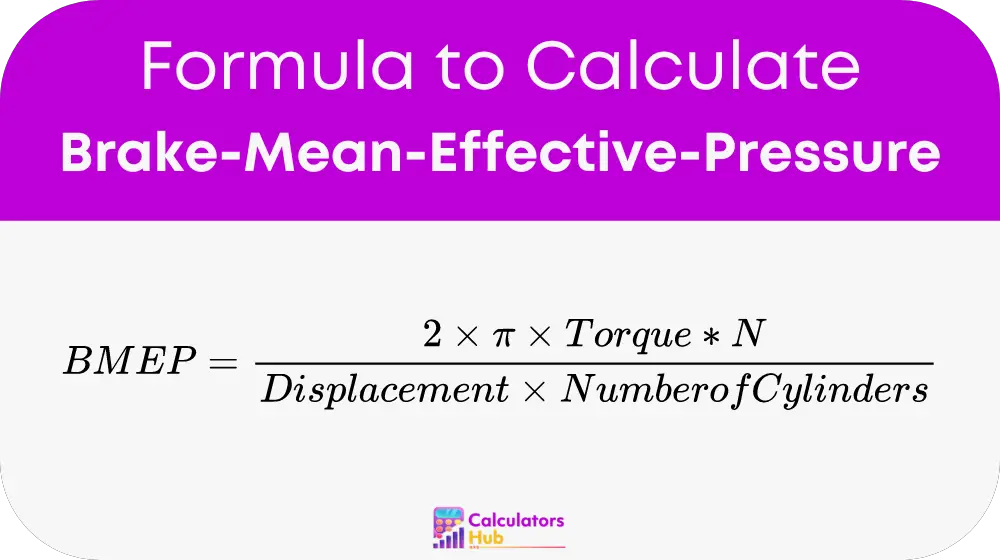The BMEP (Brake-Mean-Effective-Pressure) Calculator is a powerful tool used by engineers and automotive professionals to assess the performance of internal combustion engines. BMEP is an important metric that helps to understand the efficiency and effectiveness of an engine by relating the engine’s torque output to its displacement and the number of cylinders. This value is critical in engine design and tuning, as it provides insights into the engine's ability to generate power relative to its size.
Formula of BMEP (Brake-Mean-Effective-Pressure) Calculator
The formula to calculate BMEP is as follows:

Where:
- Torque: The engine's torque output in Newton-meters (Nm).
- N: The number of power strokes per second (for a four-stroke engine, it's half the RPM divided by 60).
- Displacement: The total engine displacement in cubic meters (m³).
- Number of Cylinders: The total number of cylinders in the engine.
Detailed Calculation Steps:
- Determine the Engine's Torque (Nm): This is the torque produced by the engine and is typically measured on a dynamometer or provided in engine specifications.
- Calculate the Number of Power Strokes per Second (N): For a four-stroke engine, this is half the RPM divided by 60. For example, if the engine is running at 6000 RPM, N would be 50.
- Measure or Obtain the Engine Displacement (m³): This is the total volume displaced by all the pistons inside the cylinders, typically provided in cubic meters.
- Identify the Number of Cylinders: This is the total number of cylinders in the engine.
- Apply the Formula: Substitute the values into the BMEP formula to calculate the Brake-Mean-Effective-Pressure.
This calculation gives you the BMEP, a measure of the engine’s ability to produce power relative to its size and configuration.
Conversion Table
To assist with quick calculations, here’s a table showing various engine configurations and their corresponding BMEP values:
| Torque (Nm) | RPM | Displacement (m³) | Number of Cylinders | BMEP (Pa) |
|---|---|---|---|---|
| 400 | 6000 | 0.002 | 4 | 1256637 |
| 500 | 5000 | 0.003 | 6 | 1047198 |
| 600 | 7000 | 0.0025 | 8 | 1340413 |
| 450 | 5500 | 0.0018 | 4 | 1759292 |
| 350 | 4500 | 0.0022 | 6 | 798488 |
This table provides a reference for common engine setups, allowing engineers to quickly estimate BMEP without performing detailed calculations.
Example of BMEP (Brake-Mean-Effective-Pressure) Calculator
Let’s walk through an example to demonstrate how the BMEP Calculator works.
Suppose you have an engine with the following specifications:
- Torque: 400 Nm
- RPM: 6000
- Displacement: 0.002 m³
- Number of Cylinders: 4
First, calculate the number of power strokes per second (N):
- N = (6000 / 2) / 60 = 50
Now, apply the values to the BMEP formula:
- BMEP = (2 * π * 400 * 50) / (0.002 * 4) = 1256637 Pa
In this example, the BMEP is 1256637 Pa (Pascals), which is a useful measure of the engine’s performance efficiency.
Most Common FAQs
BMEP is a critical measure because it provides a normalized way to compare the performance of different engines regardless of their size or configuration. It helps engineers understand how effectively an engine converts fuel into mechanical power.
Higher BMEP values typically indicate a more efficient engine that produces more power per unit of displacement. It is a key factor in engine tuning and optimization.
Yes, BMEP can be apply to all types of internal combustion engines, including four-stroke, two-stroke, gasoline, and diesel engines, making it a versatile tool in engine performance analysis.